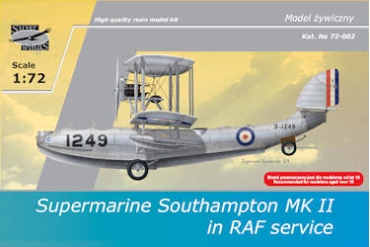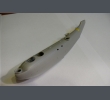Supermarine Southampton Mk II
-
 Box - RAF
Box - RAF
-
 Box - IJNAF
Box - IJNAF
History
RAF version
The Supermarine Southampton was first of a series of successful military flying boats designed by Reginald Mitchell. It was based on the civil flying boat - Supermarine Swan. After a series of modifications a single metal-hulled Southampton MKII was 500lb lighter than the wooden-hulled equivalent, and also saved another 400lb in water soakage (it was always a problem with wooden hulls, which could become rather waterlogged after long periods of operation). The Mk II was powered by two 500hp Napier Lion VA engines. A combination of lighter design and new engines increased range of the aircraft by over 500 miles. Southampton Mk II was in service of the following RAF Squadrons: No 201, 203, 204, 205, 209, 210.
IJNAF version
This twin engine flying-boat was developed for the RAF from the earlier succes fu 10 passenger civil Supermarine Swan. First version had a wooden hull, but the main production model - Mk II, had a duraluminium hull what gave a significant increase in performance. It was a biplane with under-wing stabilising floats and two 500 hp Napier Lion VA engines. The fuselage accommodated a crew of five and swept up at the rear to carry a taiplane with triple fins and rudders. Towards the end of 1928 Japanese navy purchased one of these aircrafts as they are prticularly interesed in incorporating the hull design in a projected replacement for their existing Type 15 Flying-boat, Hiro H1H1/3. After flight testing at Yokosuka the aircraft was taken to Hiro Arsenal for structural examination and design of their own version commenced during 1929. The resultant H2H1, which first flew in late 1930, generally resembled the Southampton, but it was powered by two 550 hp Hiro Type 90 engines, housed a crew of 6/7 and had only a single large tailfin and rudder. After some modifications it was adopted as Navy Type 92 Flying Boat - H2H1 in 1932 and 13 were built in total. In 1936 the imported aircraft was sold to the Japan Air Transport Research Institute who installed a passenger cabin with windows in the hull sides. Thereafter it was used by Nippon Kokuyuso Kenkyujo (NKYK) on regular passanger service during the mid-1930s.
Technical data:
Engine: 2x 500 hp Napier Lion VA
Wingspan: 22,86 m
Length: 15,15 m
Height: 6,2 m
Max speed: 153 km/h at sea level
Service ceiling: 1814 m
Range: 876 km at 139 km/h at 610 m
Endurance: 6,3 h





